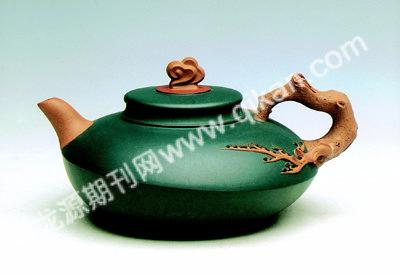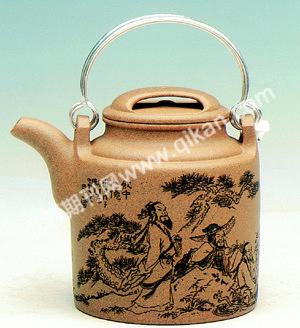Young Artist Wins Top Honors
2009-06-08ZhangShuliang
Zhang Shuliang

Making purple-clay tea kettles is more than an ordinary industrial procedure. It has long been regarded as an art, which inspires artists to make best kettles in China. The art traces back fifty centuries back and passed on from one generation of artists to the next.
Zhou Rongjin is recognized as one of the Chinas best young purple-clay tea kettle masters although he is already in his early 40s. But considering the small niche and quite a few old-generation masters, it is extremely difficult to make a young artist stand out in this ancient art. The fact that Zhou Rongjins tea kettles were selected twice as one of the top tens in two consecutive national competitions speaks well of his excellence and brilliance. Several old-generation purple-clay tea kettle masters speak highly of the young hotshot.
It is no accident that Zhou Rongjin chose something related with porcelain and pottery as his career. He is from Yixing, Jiangsu Province. Yixing enjoys national fame for its purple-clay tea kettles and the local people are proud of its purple-clay masters. Adjacent to the primary school where he studied was a porcelain workshop. Rows of finished products such as tea kettles, jars and urns on a yard outside the workshop were a constant sight. And every day he could hear loud noise made by kettle makers working beyond the school. Zhou and his playmates often talked about whose family had the best kettles. His memories are full of the traditional shapes and designs.
When he graduated from high school, Zhou naturally chose to work in a purple-clay factory. He studied carving calligraphic words on kettles under the tutelage of Master Zhang Suokun. These were probably the best years for purple-clay kettles made in Yixing. There were a few state-owned factories and there had never been any private workshop. Purple-clay tea kettles began to make money for manufactures and sellers. One day, he heard an explosive piece of news: someone in his home village sold a purple-clay kettle for 500 yuan and the kettle had cost only tens of cents originally. Back in thoseyears, 500 was a huge fortune.
Aware that there was money to be made in the kettles, Zhou realized there would be a future in kettles for him. Pretty soon he was selected by the employer to study the design of purple-clay kettles under the guidance of Fan Yongliang, a senior master of arts and crafts. Zhou has also received lessons from Master Xu Hantang. Under the guidance of these masters, Zhou has matured over a period of more than 20 years, as the result of assiduous exploring of the art of making purple-clay tea kettles. He knows he has gift, but it is his hard work that has brought him to brilliance.

Zhou Rongjin has come to know that in designing original tea kettles, nature inspires, life inspires and man gets inspired.
Zhous inspiration for his first prize-winning kettle came from his journey to the Mount Huangshan in the spring of 2001. In order to see the sunrise, he got up before the dawn, went to the top of a peak, and waited in the darkness in freezing winds. He was awe-stricken by the spectacular scene of the first sunrays bursting and streaking like arrows through darkness and targeting at the peaks and the pines. The scene was inspiring. Back home, he designed a kettle that looks like the pinewoods in the dazzling sunshine. This masterpiece was selected as one of the top ten kettles in an annual national competition for its spontaneous bold design, sophisticated workmanship and ingenious balance between tradition and innovation.
As if inspired by his own first national kudos, Zhou continued his idiosyncratic exploration. His second top-honor-winning kettle is in the shape of a basket with fruit, bamboo and plum blossoms in delicate sculpture. His other masterpieces are now in collections of museums.
In July 2007, Zhou Rongjin began to teach as a master, carrying the five-millennium tradition on to the next generation of artists.□
